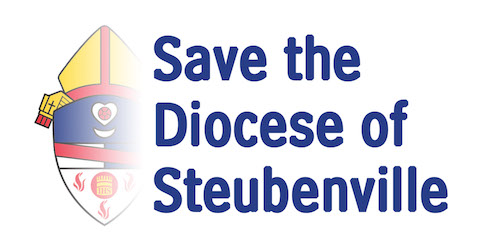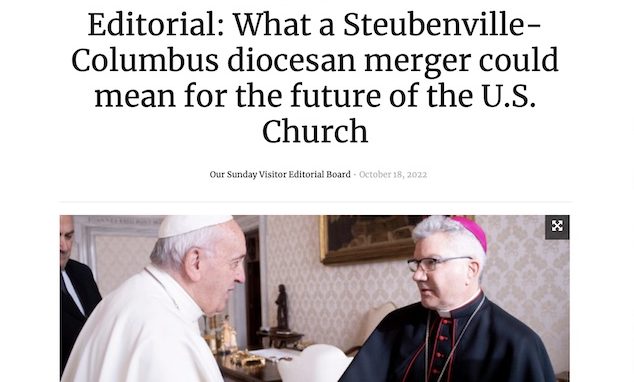OSV News published an editorial concerning the potential merger of Steubenville into Columbus. The editors look at this as a sign of things to come, and consider that it may be “a courageous and commonsense response to emptying pews, dwindling celebrations of sacraments and fewer priests.”
They commend Bishop Monforton, saying,
The decision to advocate for the suppression of one’s own episcopal see takes no small amount of humility, and, as he prepares for what most certainly would be a time of great change, Bishop Monforton should be recognized for leading his people to face the emerging picture of the landscape of American Catholic life in his diocese with courage.
They also compare our situation to moving the See of Bardstown to Louisville, as well as the merger of Juneau with Anchorage in 2020, and the merger of St. Joseph with Kansas City, Missouri in 1956.
The editorial, time and again, misses the mark.
To start with the mergers they cite: Bardstown wasn’t suppressed, the cathedra was moved. By the 1840s, it was clear that Louisville would be the dominant city in the region, so it was right that the cathedra was moved there. The analogous situation for Steubenville would be if the see city were moved to Marietta, and the Basilica down there were made the cathedral. Even at that, St. Joseph in Bardstown remains the “proto-cathedral” and holds rank within the Archdiocese of Louisville. So the diocese wasn’t suppressed, and the cathedral wasn’t eliminated entirely.
Regardiing the other two — Juneau into Anchorage and St. Joseph into Kansas City — the resultant diocese/archdiocese retained both names. The smaller of the two cities retained a “co-cathedral” and retained dignity as a diocesan see. Now we have the Diocese of Kansas City-St. Joseph, and the Archdiocese of Anchorage-Juneau. In our situation, this will be an extinctive merger. Steubenville will cease to be a see city, and in the Diocese of Columbus it will have no more rank than does Athens or Marietta or Lancaster.
So none of those cases they cite really describes our situation.
And in referring to Bishop Monforton’s “humility” when calling for this suppression, I note that they do not acknowledge his utter lack of consultation with anyone in the Diocese. He claims he did consult, but then admits that the “consultation” was about the various subjects involved, but he never actually framed any of it in terms of “Because of this I’m considering suppressing the Diocese.” I’m not sure I’d call that humility, especially in a time when the Church is touting “synodality,” and “a listening Church.”
And the material he cited, whether failing job prospects, falling population, priest shortage, finances, well, there are plenty of us who believe the numbers tell a different story.
I do not know Bishop Monforton’s motivations, but we can just as well surmise that he simply doesn’t want to do the hard work of being a bishop in a diocese like this as surmise that his motivation is humility.
So we move on to the substantive claims the article makes about the Diocese.
They note the financial scandal and the shuttered Holy Name Cathedral. A few points which the editors don’t seem to have considered:
First, the effort to renovate and renew Holy Name Cathedral was, by all reports, going very well before the revelations of the embezzlement by David Franklin and Monsignor Kurt Kemo. What this suggests is that once trust is restored the Cathedral project could resume and once again pick up steam. That would certainly take time, but it is not an insurmountable obstacle for a motivated and dedicated shepherd.
But to carry on that point: a diocese as poor as ours endured a massive embezzlement scandal, paid hundreds of thousands of dollars in back taxes and penalties, then immediately endured the closure of churches during a pandemic and still didn’t declare bankruptcy. Indeed, in his messages, Bishop Monforton has said the Diocese is “solvent.” Other dioceses in this country have declared bankruptcy due to their obligations in sex abuse settlements, and none of them is under the threat of suppression. Steubenville has remained solvent in the face of these terrible odds. So the question becomes, why is being a poor (but solvent!) diocese a reason for suppression?
They claim,
If done correctly, the merger between the Dioceses of Steubenville and Columbus could offer the opportunity for personnel and financial resources from across the state to be invested in a region with great spiritual and monetary needs. Rather than abandoning the poor population of eastern Ohio, as some have suggested, such a move would help to secure it.
So the thought is that money will be taken away from needed ministries in other parts of the state to rescue this part? Is Columbus really that wealthy? What if we don’t want to be a drain on other regions like that? What if we were given a chance to pick ourselves up after the financial scandal and move forward as a local Church? What if jobs prospects and future opportunities for industry to return to the region were much better than Bishop Monforton has led the other bishops to believe?
What of the many initiatives happening in the region, largely led by Catholics, to bolster the economy and civic involvement? Many good things are happening in and around Steubenville that no one involved in this dramatic decision seem to have taken into account.
We are not a data set to be analyzed, but a living local community working together for future flourishing.
The OSV editors also cite falling numbers of Catholics and fewer people in the pews. But the Diocese of Steubenville has one of the highest rates of Mass attendance among Catholics in the entire country.
Is the problem the sheer number of Catholics in the region being too few to justify a diocese? Steubenville is certainly one of the smallest dioceses by population in the country, but we have a much higher priest-to-faithful ratio than any of our neighboring dioceses, and at least as good a percentage of the overall population that is Catholic.
So “failing numbers in the pews” is a far larger problem for most other dioceses than for Steubenville.
The overall number of people in these 13 counties is nearly the same as it was in 1950 — six years after the Diocese was formed. We have fewer Catholics than we did then, but that only means more opportunities for evangelization. We need strong leadership from our bishop for that.
So then what motivation remains? We do not have a cathedral, that is true. Merging us into Columbus would suddenly solve that problem. But I honestly do not see another problem that we have that this helps — in fact, it seems the merger either would have no appreciable improvement, or would make things (like our priest-to-faithful ratio) worse.
OSV quotes Bishop Monforton again,
“Stubbornness would guide me to say we’ll fight this head on with really no chance,” Bishop Monforton said in a recent interview with Steubenville’s Herald-Star. Yet “it’s fortitude that has to govern the day, and that means taking a course that would be the most prudent.”
If we really had “no chance” then fighting would be stubbornness. But many in the diocese believe there is a real chance, and the Bishop, for whatever reason, has decided to make a decision during a low point.
Fortitude and prudence work for those who oppose him, also.
If OSV wants to find a diocese that can be the paradigmatic case for the shrinking church they need to look elsewhere, Steubenville is in better shape than anyone — including me until a couple of weeks ago — realizes.

